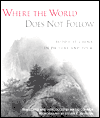 Where the World Does Not
Follow: Buddhist China in Picture and Poem.
Where the World Does Not
Follow: Buddhist China in Picture and Poem.
Translations by Mike O'Connor; photographs by Steven R. Johnson.
Somerville, MA, Wisdom Publications, 2002.
A coffee table book about Chinese hermits? If any book could be so considered
perhaps this one could. The book is about the same dimensions as a standard
piece of paper and is paperback, consisting of sixty black and white photographs
and sixty poems by twenty-five poets, translated from the original Chinese into
English. The translator's preface is an apt description:
This work, linking ancient poetry and modern photography across a span of a thousand years, is an aesthetic response to the esteemed hermit-sage tradition, or what came to be known by T'ang times as the "White Clouds." This mountain tradition, which included early shamans, Taoists, Confucian "high-minded gentlemen" who eschewed political office, was also receptive to the first Buddhist monks from India, and in time gave birth to Ch'an, or Zen, Buddhism, the most flourishing religious sect of the T'ang. Despite the enormous cultural and political upheavels in China through the ages, the White Clouds largely remain today, as before, a realm of reclusion and self-realization where the world does not follow.
Each photograph captures some rare and unique aspect of a timeless China, juxtaposed with a poem selected to reflect what the photograph might suggest. Or, conversely, a classic poem representing some aspect of hermits in T'ang China is juxtaposed by a photograph that reflects the continuity of the eremitic tradition. Where the World Does Not Follow falls into three logical features: the photos, the poems, and the presentation of both together.
Steven R. Johnson accompanied Bill Porter on his trips to China in the later 1970's and contributed a number of striking black and white shots to Porter's Road to Heaven: Encounters with Chinese Hermits. Most of those photos reappear here. All sixty photos include portraits (the most evocative) of monks and hermits -- not all Buddhist, as the subtitle suggests -- plus natural settings like mountains, cloud-topped forests, valleys, bodies of water, and also temples, farmers at work, children, and city crowds.
The poems, translated by Mike O'Connor, are accompnied by the original Chinese, a likeable practice that suggests the translator's willingness to have his work measured by the original. On a continuum of styles reflected by some of the translators mentioned in the bibliography, O'Connor tends toward the minimalist, transcribing only the essential, nearly literal. Porter himself is not dissimilar in his own published translations of Cold Mountain (Han Shan) and Stone House. Because of the personal associations (of Porter, O'Connor, Gary Snyder, photographer Johnson), one could almost call this a Port Townsend style, or Pacific Northwest style. Other translators -- Witter Brynner, A. C. Graham, Burton Watson, and Pauline Yu, are more effusive in their renderings, more representative of literary scholars who do not want to sacrifice meaning for lyricism. But O'Connor is terse without being enigmatic, obscure, or choppy, and it is a style compatiible with, indeed, complimentary to, the black and white representations of Johnson.
The familiar poets are well represented: Ch'i-chi, Han Shan, Po Chu-i, and Wang-wei, but there is welcome variety. Four different poems pursue the theme of "seeking the hermit but not finding him." Occasionally, a familiar photograph from Porter's book does not sit well with the matched poem because we know the story behind the photo. Or a new photo will require a moment to reconcile with the selected poem because the photo lacks the sense of anonymity that the poem represents, especially the case with photos of human structures like pagodas and temples and street scenes. But overall the idea works nicely, and makes a book enjoyable for browsing, reflecting, and provoking thought.
Coffee table book, then? The metaphor must be changed from coffee, but it is certainly a unique book worth sharing with visitors who come for tea. The book includes identifying notes to the photographs, bibliography, biographies of the poets, and an index of poems.
¶